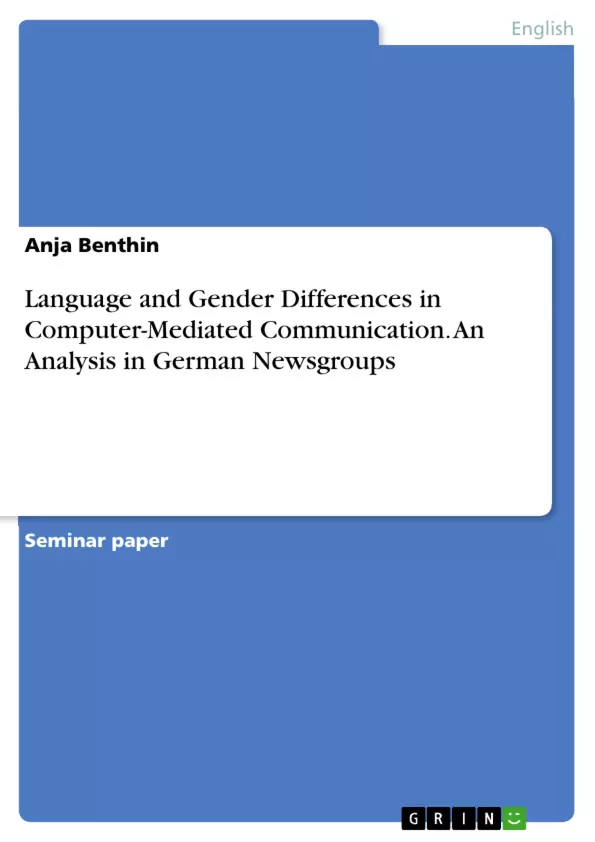As the internet, with its ever-growing number of internet users, is becoming increasingly influential in our society, the ways of interacting online are also growing in importance.
Many users seem to believe that the internet is a medium where they are able to communicate freely regardless of their appearance, social status or their gender. As a result computer mediated communication (CMC) should differ greatly compared to face-to-face communication, because of the possibility of staying anonymous and not revealing one’s true identity. This would lead one to think that women and men can participate equally online i.e. in chat rooms and newsgroups as their true gender is invisible to other users.
Inhaltsverzeichnis (Table of Contents)
- Introduction
- 1. Relationship between Language and Gender offline
- 1.1 Questions and tags
- 1.2 Interruptions and overlaps
- 1.3 Interactional styles
- 2. Research on gender and CMC
- 2.1. Participation
- 2.2 Social interaction online - interactional styles
- 2.3 The use of emoticons
- 3. Investigating gender differences in German newsgroups
- 3.1 Hypotheses
- 3.2.Method
- 3.3 Results
- 3.3.1 Participation
- 3.3.2 Interactional styles
- 3.3.3. The use of emoticons
- 4. Conclusion
Zielsetzung und Themenschwerpunkte (Objectives and Key Themes)
This paper explores the relationship between language, gender, and computer-mediated communication (CMC), particularly within German newsgroups. The objective is to investigate whether gender differences in communication styles observed offline are also evident in online environments, and to analyze the impact of these differences on the dynamics of online interactions.
- Gender differences in communication styles offline and online
- The role of language in shaping and reflecting gender identities
- Power dynamics and inequality in CMC
- The use of language features such as questions, tag questions, interruptions, and emoticons
- Comparative analysis of English-speaking and German-speaking newsgroups
Zusammenfassung der Kapitel (Chapter Summaries)
The introduction provides an overview of the growing influence of the internet and CMC in society, highlighting the perception of anonymity and potential for equal participation regardless of gender. However, the paper argues that gender differences persist in online environments, specifically in newsgroups.
Chapter 1 delves into the relationship between language and gender offline, examining key studies that explored differences in men's and women's communication styles. It discusses concepts such as tag questions, interruptions, and the role of power dynamics in shaping these styles.
Chapter 2 focuses on research on gender and CMC, including studies on participation patterns, interactional styles, and the use of emoticons in online settings.
Chapter 3 presents the investigation of gender differences in German newsgroups. This chapter outlines the hypotheses, methodology, and results of the study, focusing on participation, interactional styles, and the use of emoticons.
Schlüsselwörter (Keywords)
This study centers around the key concepts of gender, language, communication, computer-mediated communication (CMC), newsgroups, interactional styles, power dynamics, and inequality. It explores the use of linguistic features such as tag questions, interruptions, and emoticons in shaping online interactions.
- Citar trabajo
- Anja Benthin (Autor), 2007, Language and Gender Differences in Computer-Mediated Communication. An Analysis in German Newsgroups, Múnich, GRIN Verlag, https://www.grin.com/document/299195



